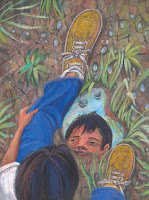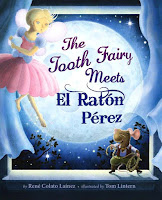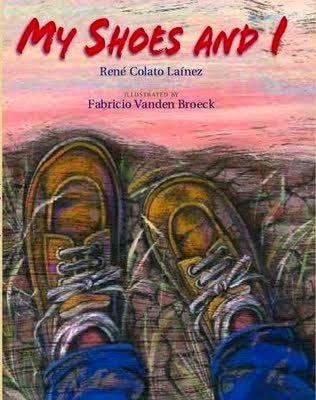Today, we are proud to host
BronzeWord's Latino Virtual Book Tour.

And we are especially eager to sing the praises of one of the LBBC's regular contributors, René Colato Laínez. We have announced the recent release of René's book,
My Shoes and I, a touching story about a young boy's journey to a new home in a new country. If you have been keeping up with the book tour, or
this blog, you will already be familiar with the story.
So our treat to you is the story of René's craft and where he receives his inspiration. Most authors will just give you the noncommittal (and somewhat bland) answer that they find inspiration "everywhere." But for many, the seeds of each story is a story in itself. Below is a synopsis of René's unusual way of finding inspiration and the unique story behind each of his books.
GIVEAWAY!
As an added bonus, one of our lucky readers will receive a signed copy of
My Shoes and I. To enter to win, simply leave a comment or question at the bottom of this post. René will be around today to respond. Only one entry per person, the winner will be chosen using Random Generator.
¡Buenas suerte!
Writing From My Own Experiences
I have a magic box. It is a box full of personal stories. Some are sad. Others are hilarious. Many offer hope and a new life. Anytime I want to write a new story, I open it and always discover great possibilities to write a wonderful manuscript. This is my inspiration box!
 In 1985, my father and I left El Salvador in search of a better life. When I left El Salvador, I was wearing a new pair of shoes that my mother sent from the United States. “René, this are very good shoes for the trip,” my father said. And indeed, my shoes were my best friends in the trip. While I drove in buses, slept in a old trailer and bus terminals, jumped in puddles, hid from storms, and climbed mountains, my shoes got old, wet, wrinkled and finally, worn down. I came to the USA with pieces of shoes. Years later, I opened my inspiration box and saw those wonderful shoes. I went to my computer and wrote MY SHOES AND I, the story of my shoes during that long and tiring trip. The book was released on February 1, 2010 from Boyds Mills Press.
In 1985, my father and I left El Salvador in search of a better life. When I left El Salvador, I was wearing a new pair of shoes that my mother sent from the United States. “René, this are very good shoes for the trip,” my father said. And indeed, my shoes were my best friends in the trip. While I drove in buses, slept in a old trailer and bus terminals, jumped in puddles, hid from storms, and climbed mountains, my shoes got old, wet, wrinkled and finally, worn down. I came to the USA with pieces of shoes. Years later, I opened my inspiration box and saw those wonderful shoes. I went to my computer and wrote MY SHOES AND I, the story of my shoes during that long and tiring trip. The book was released on February 1, 2010 from Boyds Mills Press.
The school in the new country was very different. Teachers spoke a strange language. Students moved from classroom to classroom. I was getting letters instead of numbers for my grades. The only thing I could understand from my teacher was my name, René. They did not rolled the R as we do in Spanish, but I managed to understand. René was René in English and Spanish. But one day, the teacher called my name and when I was ready to say, “Here!” a girl –yes, a muchacha- said, “Here, I am Rene.” The entire classroom filled with laughter. The boys chanted, “René has a girl’s name.” Then, they said it in Spanish because they wanted to make sure that I understood them, “René tiene de niña.” I was in shock to discover that here in the United States; Rene was a girl’s name. After, my first book was accepted for publication, I decided to write a new story. I asked my inspiration box for advice, but all I could hear was laughs and voices of boys chanting, “René has a girl’s name.” It was the time to write I AM RENÉ THE BOY (Arte Público Press 2005).
Two weeks after the incident with Rene, the girl, it was time to take my school picture. I combed my straight hair. My mamá ironed my uniform. My papá helped me to polish my new shoes. At the auditorium, the photographer told me, “Say cheese.” I ate cheese that morning and thought that maybe I had a string of cheese in the middle of my teeth. I shut my mouth. “Say cheese,” the photographer insisted. A boy told me, “Dice que te rias.” I smiled and showed all my teeth. Days later, I received my school ID. I looked at my name René Colato. I looked at the ID again and still it only said my father’s last name. They forgot to add my mother’s last name! So I went to speak to my counselor and told her that they needed to add “Laínez”, my second last name. My counselor shook her head and told me that here in the USA, I could only used my father’s last name. That afternoon my Mamá wanted to see my ID but I did not want her to see it. How could I tell her that her last name was missing? What would she say after learning that here in the new country, I needed to get use to writing only René Colato? After she looked my ID, she hugged me and said, “That’s okay, mi hijo. In your heart, you always have two last names, René Colato Laínez.” Two years ago, my inspiration box sang to me my entire name to the rhythm of the cha cha cha. I danced to my computer and wrote RENÉ HAS TWO LAST NAMES (Arte Público Press, 2009).
I am a teacher at Fernangeles Elementary School. One day, during journal time, my student Elvis asked me, “Can I write a letter to my mother? Today is her birthday. She is in Guatemala and I miss her. Can you help me?” Elvis was in my first grade class and could only write a few words. I sat down with Elvis and helped him write that letter. That night, I lay down and remembered the many times when my father was not with me. I missed him so much the two times he went to Mexico City and the time he was confused for a thief and was put in prison in El Salvador. I remembered my inspiration box. I opened it and found a word, “Waiting.” I repeated the word many times and finally said, “WAITING FOR PAPÁ.” I typed the title and began to write a story. WAITING FOR PAPÁ was my first published book (Arte Público Press, 2004).
Boo! It was Halloween time. At Fernangeles, we always have a Halloween carnival. Teachers are in charge of the booths. There is the gold fish booth, the throw-your-principal-to-the-water booth, the face painting booth and of course the Haunted House. One teacher said, “We need a lotería booth!” Yes, I agreed. “Are we selling lottery tickets?” another teacher asked. “No, lotería is a fun game!” I told her. During that Halloween carnival, I was the caller of la lotería, “El pescado, la bandera, el árbol, la sirena.” Entire families were playing lotería and having fun. Soon, a Korean girl and her mother joined the both. “It is a game in Spanish,” the girl noticed. “It is okay,” the mother said, “They are having fun and we can learn some Spanish.” In a few minutes, the girl and her mother were translating for me, “The fish, the flag, the tree, the fish lady.” The girl told her mother, “It is not a fish lady. It is a mermaid.” Pretty soon, the girl and her mother chanted, “Lotería”. They won the game! They received some special tickets that they could exchange for cool prizes. After the carnival the girl and the mother asked me where they could buy the game. That night, after I tricked and treated around my neighborhood, I opened my inspiration box and saw myself and my relatives playing lotería in El Salvador. I wrote in my notebook, PLAYING LOTERÍA. I did some revisions on the story, and Luna Rising acquired it in 2005.
“Ahhh, one of my students lives among rats and mice,” a teacher screamed in the hallway. “I need to go to the office and call social services,” she added. The teacher was ready to faint from the impression. I asked her what was happening and she told me that one of her students lost his first tooth and that a mouse took it. But this was not the worst part. All the other students said that they knew that mouse, too. This boy told her that the mouse visited his home often because he lived with his brothers and cousins. That boy was thrilled to lose that tooth and he waited for that mouse the entire night. “The boy said that he wants that mouse to visit his house every night,” the teacher concluded. I asked her if she knew about El Ratón Pérez, the Hispanic tooth collector. “In Latin America we don’t have a Tooth Fairy, but we have el Ratón Pérez. Last night this famous and adventurous mouse visited your student. He collected all my teeth, also,” I told her. The teacher laughed and did not go to the office. She went to celebrate with her student the loss of his first tooth. When I arrived home, I opened the inspiration box and saw the Tooth Fairy and El Ratón Pérez fighting over a tooth. It was time to write THE TOOTH FAIRY MEETS EL RATÓN. The book comes out on March 23, 2010.
I know that there are many adventures and life experiences inside that inspiration box. Stories that are waiting and eager to become new books. Let me open it and see what I find. What a great idea! I better stop. My computer is waiting for me.
Happy writing and saludos,
René Colato Laínez

 After this incident, I wondered what would happen if the Tooth Fairy met El Ratón Pérez for the first time? What would they say to each other? Would they get along? Read and find out. My new book, The Tooth Fairy Meets El Ratón Pérez, was released by Tricycle Press/Random House on March 23, 2010.
After this incident, I wondered what would happen if the Tooth Fairy met El Ratón Pérez for the first time? What would they say to each other? Would they get along? Read and find out. My new book, The Tooth Fairy Meets El Ratón Pérez, was released by Tricycle Press/Random House on March 23, 2010.






















